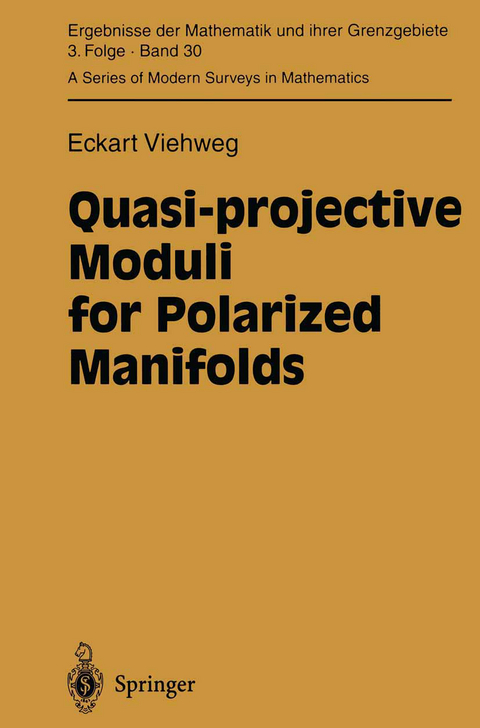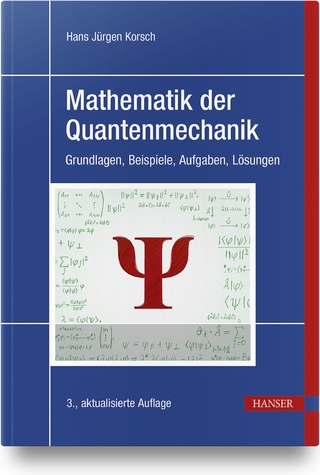
Quasi-projective Moduli for Polarized Manifolds
Springer Berlin (Verlag)
978-3-642-79747-7 (ISBN)
The subject of the book are construction techniques for classifying spaces of projective manifolds and positivity results for direct image sheaves. Both together allow the proof of the central result, the existence of quasi-projective moduli schemes for a large class of manifolds. The book is of great interest for researchers and graduate students in algebraic geometry or number theory.
Leitfaden.- Classification Theory and Moduli Problems.- Notations and Conventions.- 1 Moduli Problems and Hilbert Schemes.- 1.1 Moduli Functors and Moduli Schemes.- 1.2 Moduli of Manifolds: The Main Results.- 1.3 Properties of Moduli Functors.- 1.4 Moduli Functors for ?-Gorenstein Schemes.- 1.5 A. Grothendieck's Construction of Hilbert Schemes.- 1.6 Hilbert Schemes of Canonically Polarized Schemes.- 1.7 Hilbert Schemes of Polarized Schemes.- 2 Weakly Positive Sheaves and Vanishing Theorems.- 2.1 Coverings.- 2.2 Numerically Effective Sheaves.- 2.3 Weakly Positive Sheaves.- 2.4 Vanishing Theorems and Base Change.- 2.5 Examples of Weakly Positive Sheaves.- 3 D. Mumford's Geometric Invariant Theory.- 3.1 Group Actions and Quotients.- 3.2 Linearizations.- 3.3 Stable Points.- 3.4 Properties of Stable Points.- 3.5 Quotients, without Stability Criteria.- 4 Stability and Ampleness Criteria.- 4.1 Compactifications and the Hilbert-Mumford Criterion.- 4.2 Weak Positivity of Line Bundles and Stability.- 4.3 Weak Positivity of Vector Bundles and Stability.- 4.4 Ampleness Criteria.- 5 Auxiliary Results on Locally Free Sheaves and Divisors.- 5.1 O. Gabber's Extension Theorem.- 5.2 The Construction of Coverings.- 5.3 Singularities of Divisors.- 5.4 Singularities of Divisors in Flat Families.- 5.5 Vanishing Theorems and Base Change, Revisited.- 6 Weak Positivity of Direct Images of Sheaves.- 6.1 Variation of Hodge Structures.- 6.2 Weakly Semistable Reduction.- 6.3 Applications of the Extension Theorem.- 6.4 Powers of Dualizing Sheaves.- 6.5 Polarizations, Twisted by Powers of Dualizing Sheaves.- 7 Geometric Invariant Theory on Hilbert Schemes.- 7.1 Group Actions on Hilbert Schemes.- 7.2 Geometric Quotients and Moduli Schemes.- 7.3 Methods to Construct Quasi-Projective ModuliSchemes.- 7.4 Conditions for the Existence of Moduli Schemes: Case (CP).- 7.5 Conditions for the Existence of Moduli Schemes: Case (DP).- 7.6 Numerical Equivalence.- 8 Allowing Certain Singularities.- 8.1 Canonical and Log-Terminal Singularities.- 8.2 Singularities of Divisors.- 8.3 Deformations of Canonical and Log-Terminal Singularities.- 8.4 Base Change and Positivity.- 8.5 Moduli of Canonically Polarized Varieties.- 8.6 Moduli of Polarized Varieties.- 8.7 Towards Moduli of Canonically Polarized Schemes.- 9 Moduli as Algebraic Spaces.- 9.1 Algebraic Spaces.- 9.2 Quotients by Equivalence Relations.- 9.3 Quotients in the Category of Algebraic Spaces.- 9.4 Construction of Algebraic Moduli Spaces.- 9.5 Ample Line Bundles on Algebraic Moduli Spaces.- 9.6 Proper Algebraic Moduli Spaces for Curves and Surfaces.- References.- Glossary of Notations.
| Erscheint lt. Verlag | 27.12.2011 |
|---|---|
| Reihe/Serie | Ergebnisse der Mathematik und ihrer Grenzgebiete. 3. Folge / A Series of Modern Surveys in Mathematics |
| Zusatzinfo | VIII, 320 p. |
| Verlagsort | Berlin |
| Sprache | englisch |
| Maße | 155 x 235 mm |
| Gewicht | 504 g |
| Themenwelt | Mathematik / Informatik ► Mathematik ► Analysis |
| Mathematik / Informatik ► Mathematik ► Geometrie / Topologie | |
| Schlagworte | Algebraic Geometry • algebraic spaces • Algebraische Räume • Birationale Geometrie • birational geometry • Divisor • Geometric invariant theory • Geometrische Invarianten-Theorie • Grothendieck Topology • manifold • Moduli Schemata • Moduli schemes • Polarisierte Mannigfaltigkeiten • polarized manifolds • Schema |
| ISBN-10 | 3-642-79747-4 / 3642797474 |
| ISBN-13 | 978-3-642-79747-7 / 9783642797477 |
| Zustand | Neuware |
| Haben Sie eine Frage zum Produkt? |
aus dem Bereich


